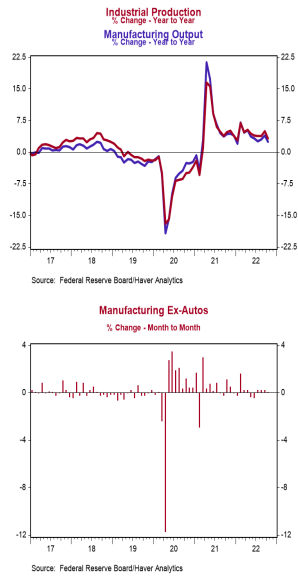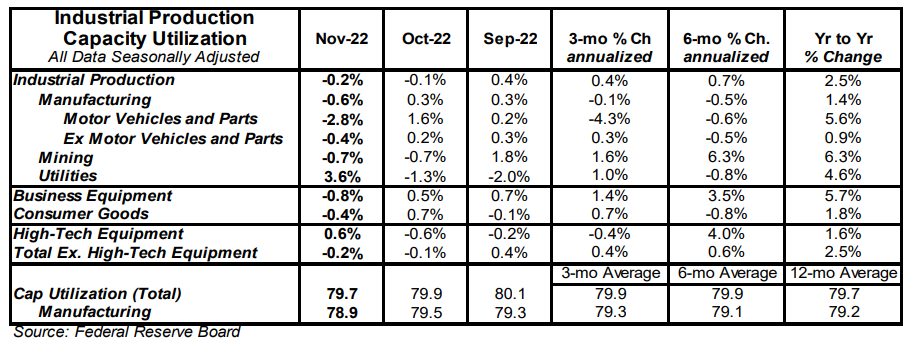- Industrial production declined 0.2% in November, lagging the consensus expectation of no change. Utilities output rose 3.6% in November, while mining dropped 0.7%.
- Manufacturing, which excludes mining/utilities, declined 0.6% in November (-1.3% including revisions to prior months). Auto production fell 2.8%, while non-auto manufacturing declined 0.4%. Auto production is up 5.6% in the past year, while non-auto manufacturing is up 0.9%.
- The production of high-tech equipment increased 0.6% in November and is up 1.6% versus a year ago.
- Overall capacity utilization declined to 79.7% in November from 79.9% in October. Manufacturing capacity utilization fell to 78.9% in November from 79.5%.
Implications:
Industrial activity in the US fell for a second straight month in November, with nearly all major categories posting declines. The manufacturing sector was the biggest contributor to today’s negative headline number, with production falling 0.6%. Looking at the details, both auto and non-auto manufacturing dropped in November, posting declines of 2.8% and 0.4% respectively. Given the recent trend of American consumers shifting their preferences back toward services and away from goods, today’s weak numbers out of the manufacturing sector aren’t surprising. That said, production of consumer goods is up 1.8% in the past year while the production of business equipment is up 5.7%. This signals that investment in capital goods might be beginning to drive demand for the manufacturing sector as end-consumers ease up. Another source of weakness in today’s report was the mining sector, which posted a decline of 0.7% in November. A slower pace of crude oil, natural gas, and other mineral extraction more than offset gains in the drilling of new wells. However, this signals that oil prices, which are currently still hovering near $80 a barrel, continue to incentivize new exploration. Given that this exploration will translate into more production in the near future, mining could be a source of relative strength for industrial production in 2023. Finally, the one bright spot in today’s report came from the utilities sector (which is largely dependent on weather), which posted a gain of 3.6% in November. In other manufacturing news this morning, the Empire State Index, a measure of New York factory sentiment, fell to -11.2 in December from +4.5 in November. Meanwhile, the Philadelphia Fed Index (its counterpart from that region) rose to -13.8 in December from -19.4 in November. We continue to anticipate a recession in 2023, with the goods sector leading the way. However, continuing strength in services tells us it isn’t here yet.





